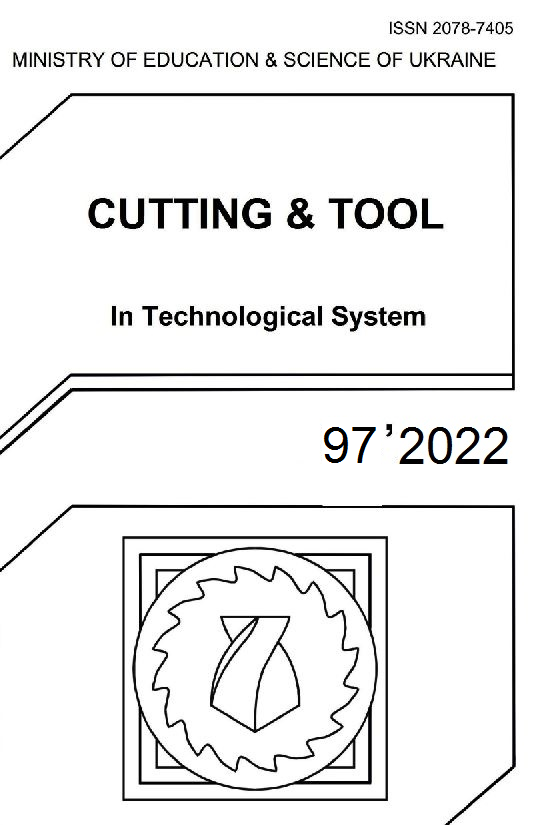FEM ANALYSIS OF THE BURNISHING PROCESS OF X5CrNi18-10 STAINLESS STEEL
DOI:
https://doi.org/10.20998/2078-7405.2022.97.12Keywords:
burnishing, design of experiments, FEM simulationAbstract
The burnishing process can improve the surface roughness of machined parts, while having an advantageous effect on the properties of the layer below the surface. In this paper the effect of the surface speed, the feed rate and pressing force are analysed with Finite Element Method. The affected width and depth were analysed during one pass of the burnishing tool. We also examined the highest pressure and the stress distribution of the surface layer. The values of the studied parameters were chosen according to the “Design of Experiments” method. Equations determining the studied properties were also given.
References
Grewal S. Manufacturing process design and costing an integrated approach (1st ed. 2011). Springer London : Imprint: Springer.
Kovács, Gy.: Optimization of structural elements of transport vehicles in order to reduce weight and fuel consumption. STRUCTURAL ENGINEERING AND MECHANICS 71 : 3 pp. 283-290. , 8 p. 2019.
Duncheva, G.V., Maximov, J.T., Anchev, A.P., Dunchev, V.P., Argirov, Y.B., Kandeva-Ivanova, M.: Enhancement of the wear resistance of CuAl9Fe4 sliding bearing bushings via diamond burnishing. Wear, Volumes 510–511, 204491, 2022.
Raza, A., Kumar, S.: A critical review of tool design in burnishing process. Tribology International, Volume 174, 107717, 2022.
Mohamed, T., Hamid, H., Salah, A. and Salim B.:"Effect of Roller Burnishing Parameters on Roughness Surface and Hardness of Unalloyed S 355 J0 Steel by Using Response Surface Methodology. Manufacturing Technology, vol. 17, pp. 602-10, 2017.
Fedorovich, V., Pyzhov, I., Kundrak, J., Pupan, L., & Voloshkina, I.: Simulation methodology of diamond burnishing. In Design, Simulation, Manufacturing: The Innovation Exchange (pp. 363-372). Springer, Cham. 2021.
Attabi, S., Himour, A., Laouar, L., Motallebzadeh, A.: Mechanical and wear behaviors of 316L stainless steel after ball burnishing treatment. Journal of Materials Research and Technology, Volume 15, Pages 3255-3267, 2021.
Yaman, N., Sunay, N., Kaya, M., Kaynak, Y.: Enhancing Surface Integrity of Additively Manufactured Inconel 718 by Roller Burnishing Process, Procedia CIRP, Volume 108, Pages 681-686, 2022.
Teimouri, R., Grabowski, M., Bogucki, R., Ślusarczyk, Ł., Skoczypiec, S.: Modeling of strengthening mechanisms of surface layers in burnishing process. Materials & Design, Volume 223, 111114, 2022.
Barahate, V., Govande, A. R., Tiwari, G., Sunil, B. R., Dumpala, R.: Parameter optimization during single roller burnishing of AA6061-T6 alloy by design of experiments. Materials Today: Proceedings, Volume 50, Part 5, pp 1967-1970, 2022.
Borysenko, D., Welzel, F., Karpuschewski, B., Kundrák, J., Voropai, V: Simulation of the burnishing process on real surface structures. Precision Engineering, Volume 68, Pages 166-173, 2021.
Ferencsik, V. and Gál, V.: FE Investigation of Surface Burnishing Technology. Cutting & Tools in Technological System, (93), pp.3-8. 2020
Downloads
Published
Issue
Section
License
Copyright Notice
Authors who publish with this Collection agree to the following terms:
1. Authors retain copyright and grant the Collection right of first publication with the work simultaneously licensed under a Creative Commons Attribution License that allows others to share the work with an acknowledgement of the work's authorship and initial publication in this Collection.
2. Authors are able to enter into separate, additional contractual arrangements for the non-exclusive distribution of the Collection's published version of the work (e.g., post it to an institutional repository or publish it in a book), with an acknowledgement of its initial publication in this Collection.
3. Authors are permitted and encouraged to post their work online (e.g., in institutional repositories or on their website) prior to and during the submission process, as it can lead to productive exchanges, as well as earlier and greater citation of published work.

